Where to buy denatured alcohol?
As regulations evolve, finding this solvent is going to require some creativity.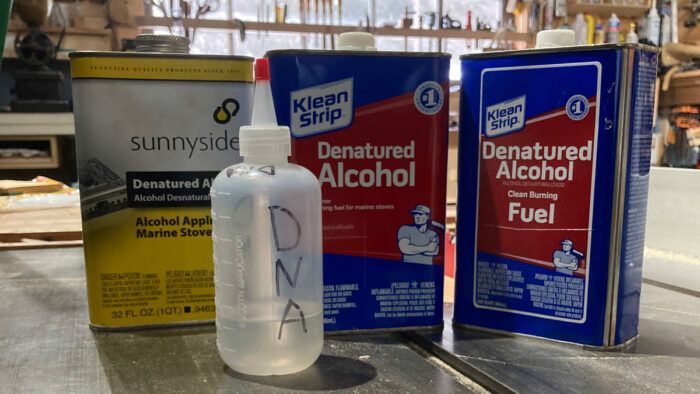
Denatured alcohol, a staple in most woodworking shops, is changing. Due to new regulations—particularly those in California—it’s nearly impossible for some woodworkers to buy denatured alcohol. I haven’t had a problem finding it here in Connecticut, but I did notice the addition of “fuel” to the label. Knowing that many backpackers and boaters use denatured alcohol for cooking purposes, I figured that was a marketing ploy. While that may or may not be the case, there’s probably more to it than that, and in this post we’ll dive deeper into the changes behind that label. We’ll also share some sources and alternatives for those who aren’t able to buy denatured alcohol locally anymore.
Denatured alcohol vs. “fuel”
“Natural” alcohol is ethanol, the active ingredient in your favorite alcoholic beverages. Drinking alcohol is regulated, and more importantly taxed, by the government. As woodworkers, we’re not interested in drinking the stuff, most often we want to use it as a solvent for shellac. So manufacturers denature it, or add poison, so we can’t drink it. There are various ways of doing this, but most often this is done by adding methanol, otherwise known as wood alcohol. For what it’s worth, the top search result for “wood alcohol” brings you to a page on cancer.gov—rarely a comforting sign.
I’m not known for my cautious nature, but if I am going to be breathing in fumes from my finish, and getting it on my hands, and have the option of doing it with less poison, I want that one! Both ethanol and methanol are inherently volatile and evaporate completely in a fully cured finish. There is little evidence that a shellac finish suffers when more methanol is added to our denatured alcohol. However, there is no reason to take methanol lightly with regard to safety during use.
The version found most often in your local hardware store is labeled “fuel.” There are two brands of solvent commonly found in local hardware stores, Klean Strip and Sunnyside. Klean Strip lists the denatured alcohol on their website as a heating fuel, and according to the material safety data sheet (MSDS) it contains 30%-60% ethanol and 30%-60% methanol. The same mix applies to Sunnyside. In other words, the product in the can is either mostly ethanol, or mostly methanol—your guess is as good as mine. Thankfully, Klean Strip has a “Green” line of solvents. Their “Green” denatured alcohol is 80%-100% ethanol, and 3%-7% methanol, a major reason Klean Strip Green is often recommended as the best solvent for shellac.*
*As of July of 2020, Klean Strip now has their “Green” denatured alcohol listed as discontinued. Stock up if you find some.
Where can’t you buy denatured alcohol?
While this question might seem silly, we posted a survey and received over 200 responses from all over the United States and Canada. Around 40% of respondents reported difficulty buying denatured alcohol—over half of those responses were from woodworkers in California. Many in Canada, particularly in Ontario and Quebec, aren’t able to buy it locally. There seems to be a few sources and loopholes though, and we’ll share them below.
California
We’re not going to get into the why of it—or for that matter, if the why even makes sense—but the California Air Resource board banned the sale of denatured alcohol around two years ago. Since then, many woodworkers have had to get creative in sourcing their favorite shellac solvent. I reached out to a few highly regarded woodworkers and asked them where they source their denatured alcohol. I have chosen to redact the names of those I deem awesome.
Woodworker #1 replied:
“I am not a lawyer, I just want to clean my shellac brush. Fortunately for me, I have a son who lives in [redacted] Arizona. From time to time he buys the environmentally clean denatured alcohol at the local Home Depot. That is all I can say on the matter. However, my shellac brushes are clean.”
Woodworker #2 simply replied “Arizona.”
Woodworker #3 reported that they are still able to get it at a hardwood dealer that sells a lot of high-end and tough-to-find finishing supplies. I confirmed that this is because some of the regulations are more relaxed in San Diego county than in the rest of the California.
For what it’s worth, one respondent from the survey told me that they get denatured alcohol from their cannabis growing supply store.
Let’s be clear, it is illegal to cross state lines with banned products, and it would also be illegal for me to buy a can of denatured alcohol and send it to my friend in Los Angeles.
Canada
I was surprised to see that denatured alcohol has become hard to get in some (all?) parts of Canada. Respondents in Ontario and Quebec reported that they can only get it at Lee Valley, Motion Canada, Juneau Peinture, and La Maison du peintre. Online, Lee Valley’s version is listed as “Shellac/Lacquer Thinner” (more on that below). Motion has denatured alcohol listed on their website, but only as a factory order item.
Specialty supply stores in other regions
Respondents in Colorado, Georgia, and Pennsylvania have reported it isn’t available on the shelves of their local home center, but they were able find it at a painting supply or woodworking supply store.
Some have said that they find denatured alcohol sold as “fuel” from camping suppliers such as REI and from boating suppliers. That said, check the MSDS sheet because that type of mixture will likely have high amounts of methanol.
Methyl Hydrate – Commonly found in CanadaMike Mascelli discusses Methyl Hydrate, and if it’s a usable substitute in the shop. |
Online suppliers
Currently there are a few places selling denatured alcohol online and shipping to many places we’ve mentioned that won’t allow local sales. You’re likely to pay a premium, but considering most woodworkers rarely use more than a gallon of denatured alcohol a year, it may be worth the added costs, even with shipping.
As of the time of this posting, you can purchase denatured alcohol from ShellacFinishes.com and Mohawk-Finishing.com.
Alternatives to denatured alcohol
For many woodworkers, the alternatives to denatured alcohol are actually their preferred shellac solvent, and for good reason.
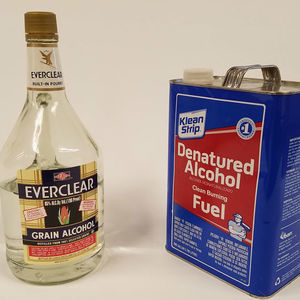
Grain alcohol – Grain alcohols, such as Everclear and Graves, are often found in your local liquor store. The higher the proof, the more pure it is, so many woodworkers prefer 190-proof grain alcohol. Some have had success with 151-proof, but it’s probably best to avoid 120-proof because at that point you’re introducing more water into your finishing solution than you probably want. Unfortunately, higher-proof grain alcohol is not available in California and many other regions.
Culinary solvent – Until recently, I hadn’t known of the existence of culinary solvent—which for all intents and purposes, is just pure 200-proof ethanol, manufactured and packaged for use as an ingredient in perfumes, cosmetics, mouthwash, and other products. You’ll pay a premium for it, but currently, CulinarySolvent.com states that they ship to 39 states, including California. Some states require a permit before shipping.
Director of The Krenov School Laura Mays told me:
“At the school we bought a 5-gallon can of food-grade alcohol, which is 200-proof ethanol. It’s about $350 for the 5 gallons because of a massive tax on it. $350 seems like a lot but it works out at $17.50 a quart, which isn’t so so bad. And I never had any problems using the hardware stuff for shellac but the food-grade stuff is, in theory at least, perfect!”
Shellac reducer – Lee Valley and Mohawk both sell a product labeled as “Shellac reducer” or “Shellac/Lacquer reducer.” Lee Valley states that their version is a mix of ethanol and isobutyl alcohol. Mohawk’s Shellac reducer MSDS declares it is ethanol, butanol, and isopropanol.
Both isobutyl alcohol and butanol are otherwise known as Isobutanol or 2-Methyl-1-propanol, and is a synthesized alcohol. Isopropanol is commonly found in rubbing alcohol. Both are likely used as a denaturant, and at first glance shouldn’t affect shellac solubility and may be marginally safer than methanol.
Lee Valley does not have an MSDS sheet on their site for their shellac reducer, but Mohawk’s consists of 75%-100% ethanol and 2.5%-10% butanol, and isopropanol, a ratio reminiscent to Klean-Strip Green denatured alcohol.
Looking forward
I think I’ll head down to the local liquor store next time I need shellac solvent. It just seems simpler and given the amount of denatured alcohol I go through, I won’t go broke doing it. It is likely that many woodworkers will be forced to do the same, or switch to shellac reducer. Time will tell how shellac reducer acts when mixed with our favorite shellac flakes, but I know that woodworkers are industrious and creative, and I doubt that simple chemistry will ever get between us and a perfect French polished finish!
*Thank you to William Hoffman, a materials scientist, for the help on this article.
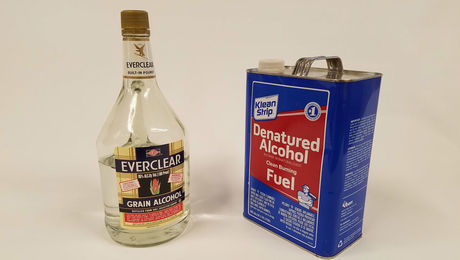 |
Shellac Solvent: Grain Alcohol vs. Denatured AlcoholBob Miller explains why you should head to the local liquor store before applying your next shellac finish |
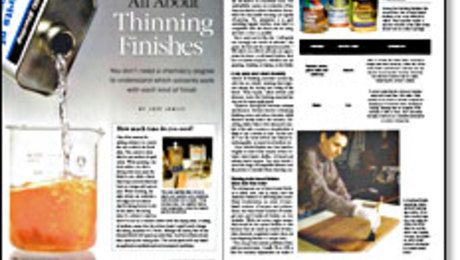 |
All About Thinning FinishesYou don’t need a chemistry degree to understand which solvents work with each kind of finish |
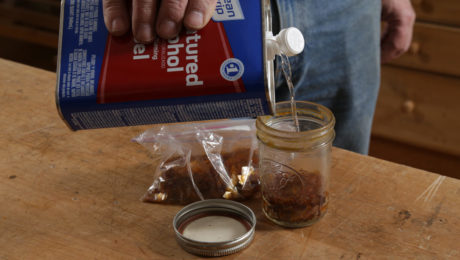 |
Mix Your Own ShellacHow to make a batch of shellac from fresh flakes. |
Fine Woodworking Recommended Products

Waterlox Original

Foam Brushes

Osmo Polyx-Oil























Comments
Thanks Ben. I learned a bunch of things.
I have no trouble, yet, getting denatured alcohol here in MA. But knowing alternatives and distinctions is helpful.
I have been aware of the hazards of using anything containing methanol, though, and use it only outside of the shop as brush cleaner. One of the reasons I like the premixed Zinsser Sealcoat is that it is shellac and ethanol, without any methanol at all.
Be on the look out for my follow up piece "Why the heck do I need to drive to Massachusetts to get Naptha?"
Ha! Stop by the next time you're in southeastern MA.
AFAIK, in California it is the sale, supply or manufacture for use (in CA) of DNA that is illegal; individual possession or purchase is not. Nor, to my understanding, the application of DNA. (CARB § 94507) Much like 20th-century prohibition which outlawed the sale, manufacture for sale and transportation but NOT the possession or drinking of alcohol. Interstate transportation and commerce are things feds/state can regulate more easily than personal possession and consumption.
Again in CA, I believe the same is true for grain alcohol > 120 proof.
Personally don't have trouble lawfully purchasing (at least for me) ethanol from web vendors who willingly ship to CA. That has, though, more than doubled the cost (~ $35/gal).
Per Megan Fitzpatrick's recommendation, I've been using 190 proof grain alcohol for my shellac. It's cheap and easily available in Texas.
I'd love to see a side by side "quality of finish" article with a single bag of shellac flakes and the various versions of booze/fuel/poison/thinner/solvent/DNA... Diff or no diff judgement on the furniture's finish without regard to the rest.
We were just talking about how to pull this off. I think it would also require nose plugs, gloves and a lot of laughing.
I primarily finish with shellac and now mostly dissolve my own from shellac flakes. I have used 190 proof Everclear (stuff you can drink), denatured alcohol that has just methanol, denatured alcohol that has a mixture of isopropanol and buntanol added. I can't tell a difference in the fnished product when it has dried. Where I do notice a difference is that shellac solvent that has the isoprpanol/butanol added to it, you can feel a very slight drag as you run your fingers across it after it has sat for the same time that either 190 alcohol on DNA with methanol would feel dry. Being a chemist, I have just assumed that is due to the butanol taking longer to evaporate. My preference is to use 190 proof alcohol with the thought being if I can drink it, it is likely less hazardous to my health.
This is very helpful, Ben. Thank you.
Thanks Ben. I live in CA. I have switched to the Mohawk stuff and it works fine. Personally, I'd prefer to just use 190 proof alcohol and pay the sin tax even though I'm not drinking it. However in CA, you cannot purchase 190 proof legally. I don't know why.
Since DNA is hard to get, I have switched to cleaning my shellac brushes with 90% ispropanol which I can easily get. Works well. I might try using that as a shellac solvent substitute. Again, I'd prefer to use 190 proof ethanol if I am going to breath any fumes of any kind.
For small projects I use Zinsser Bulls Eye Sealcoat and usually like the results. Out of curiosity I went their website to see what the make up is of Sealcoat, Ethanol 50-75%, Shellac 10-25% and 2-Propanol 2.5-10% (Printed on 1/11/21)
Thanks for the article, Ben. And looking forward to find out where we can get naphtha here in Connecticut LOL.
Klean Strip Green availability is a crap shoot. Just gotta look around. Last fall I bought 4 qts for $7.99 each (gallons not available), with free shipping from Woodcraft online. Now it's not listed there.
Today I can buy it for $17.99 / qt on Amazon Prime (free ship). But it varies constantly, and prices are of course high.
I see Quality Chemical sells 190 proof DNA. It's available on their site for $35/gal, plus $14 ship (to CT). It also happens to be available on Amazon for $37/gal, free ship for Prime members. The reviews there are confusing, but the MSDS on their site looks good. Simply: one ingredient is listed, ethanol, >95%.
https://www.qualitychemical.com/Denatured-Alcohol-Ethanol-190-proof_ASH-461
EDIT to add: Quality Chemical also has "200 proof denatured" for the same price, and the MSDS says ethanol > 96%. And they also sell this on Amazon, free shipping.
A 190 proof brand not mentioned is Lynsol, a denatured alcohol proprietary solvent meeting U.S. Government Specifications and complies with existing air pollution control regulations. It is the purest ethyl alcohol to thin shellac, stain sealers or spirit varnishes. The MSDS data sheet is at https://savogran.com/pdfs/LYNSOL_MS.pdf.
As a chemistry student a million years ago, in an organic lab session I was asked to go to the basement to the locked storage room and fetch 2 jugs of 95% ethanol. When I returned, the prof had left and I still had the key, which was duplicated as fast as I could get to the hardware store.
A pint lab bottle of 95% in a gallon of orange juice went a looong way. And almost no hangover.
The funny part was when the prof told us too much ethanol was disappearing and he intended to denature it with phenophthalein. I began testing every batch. A fellow whose dad was head of the math department was not so wise. He had been turned for med school and decided to tie one on. He spent a week in the hospital, lost about 15 pounds (pheophthalein is the active ingredient in ExLax.) Afterward, every time the fellow walked into the lecture, the prof would have to excuse himself and laugh in the hall for a few minutes, reentering muttering something about stupid sunny beaches.
P.S.; before graduation, I sold the key for $25.
Hi , I use BioEthanol - it is the ethanol used for ethanol fireplaces. It is even better than everclear since everclear is distilled alcohol - Ethanol forms a mixture with water called an azeotrope which means that no matter how much you distill it, it will never separate more than around 95%. Bioethanol is chemically dried to more than 95% with a miniscule amount of denaturant added to it, not to mention it is MUCH cheaper than everclear as you dont have to pay excise tax on it... it might be an option for guys that cant find ethanol
Darryl,
Mind sharing your source? You can email me if you like at [email protected].
Phil Lowe always recommended Lynsol for mixing shellac. It's 95% ethanol. I've read many alcohol warnings and they never mention Lynsol. See my #13 post above.
Log in or create an account to post a comment.
Sign up Log in